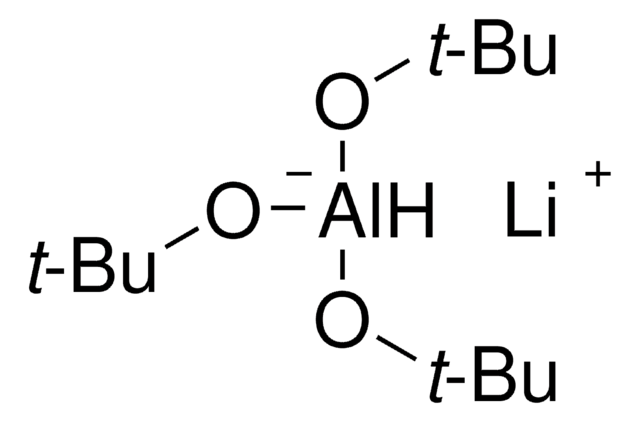196193
Red-Al® sodium bis(2-methoxyethoxy)aluminum hydride solution
≥60 wt. % in toluene
Synonym(s):
SBAH, Sodium bis(2-methoxyethoxy)aluminum dihydride, Sodium dihydrido-bis(2-methoxyethoxy)aluminate
About This Item
Recommended Products
vapor pressure
21 mmHg ( 20 °C)
Quality Level
expl. lim.
7 %
reaction suitability
reagent type: reductant
concentration
≥60 wt. % in toluene
density
1.036 g/mL at 25 °C
functional group
ether
SMILES string
[Na+].[H][Al-]([H])(OCCOC)OCCOC
InChI
1S/2C3H7O2.Al.Na.2H/c2*1-5-3-2-4;;;;/h2*2-3H2,1H3;;;;/q2*-1;2*+1;;
InChI key
XJIQVZMZXHEYOY-UHFFFAOYSA-N
General description
- Aldehydes, ketones, esters, and anhydrides to primary alcohols.
- Ketoximes and aldoximes to primary amines.
- Cyclic compounds such as lactones and epoxides to diols.
It is also used as a catalyst in the ring-opening polymerization reactions.
SBAH is a reducing agent used to reduce functional groups like carbonyls, amides, epoxides, esters, and carboxylic acids.
Application
- A tosyl deprotecting agent.
- A catalyst for crosslinking of polyvinylsilanes (PVS) by Si-Si dehydrocoupling reaction in the presence of group 4 metallocene complexes.
- A reducing reagent for the synthesis of optically active N-protected amino alcohols and peptide alcohols.
Legal Information
Signal Word
Danger
Hazard Statements
Hazard Classifications
Aquatic Chronic 3 - Asp. Tox. 1 - Eye Dam. 1 - Flam. Liq. 2 - Repr. 2 - Skin Corr. 1B - STOT RE 2 Inhalation - STOT SE 3 - Water-react 1
Target Organs
Central nervous system
Supplementary Hazards
Storage Class Code
4.3 - Hazardous materials which set free flammable gases upon contact with water
WGK
WGK 3
Flash Point(F)
39.2 °F - closed cup
Flash Point(C)
4 °C - closed cup
Regulatory Listings
Regulatory Listings are mainly provided for chemical products. Only limited information can be provided here for non-chemical products. No entry means none of the components are listed. It is the user’s obligation to ensure the safe and legal use of the product.
PRTR
Class I Designated Chemical Substances
FSL
Group 3: Spontaneously combustible substances and water- reactive materials
Materials containing Organometallic compounds
Hazardous rank II
2nd spontaneously combustible materials and water reactive materials
ISHL Indicated Name
Substances Subject to be Indicated Names
ISHL Notified Names
Substances Subject to be Notified Names
JAN Code
196193-50G:4548173112985
196193-10KG:
196193-1KG:
196193-2.5L:
196193-250G:
196193-5KG:
196193-500G:4548173112978
196193-PZ:
196193-VAR:
196193-BULK:
Choose from one of the most recent versions:
Already Own This Product?
Find documentation for the products that you have recently purchased in the Document Library.
Customers Also Viewed
Articles
Red-Al®, or sodium bis(2-methoxyethoxy)aluminum dihydride (Vitride®, SMEAH), is a versatile reducing agent and a good substitute for LiAlH4 in many reactions. Red-Al® is nonpyrophoric, although still moisture-sensitive, and is available in solution, allowing for easier handling compared to LiAlH4.
Our team of scientists has experience in all areas of research including Life Science, Material Science, Chemical Synthesis, Chromatography, Analytical and many others.
Contact Technical Service










